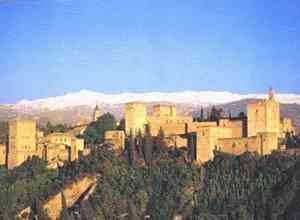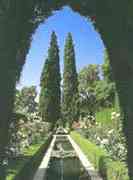Granada Showcases Spain’s Moorish Past
Nowhere is Spain’s incredible beauty and contrasting diversity more vividly evident than in Granada. As you stand at the top of the Alhambra fortress tower, circle your gaze and appreciate Granada’s wonders. Gazing south, note the high, often snow-covered, Sierra Nevada range. East, see industrial Granada and a broad, dry plateau. To the northeast and below, scan the heart of Granada, making out Plaza Nueva, the Spanish Cathedral, and the Moorish marketplace (Alcaiceria). Gazing north across the Darro River Valley, view the Moorish quarter (Albaicin) with its narrow, winding streets ascending the hill. To the west, behold the incredible Alhambra grounds: the fortress ruins (Alcazaba), the Moorish palaces (Palacios Nazaries), and the Palace of King Carlos V. Alhambra’s diversity and history beckon you to further explorations.
 |
 |
See the History
Alhambra’s history speaks through its many sites and buildings, spanning the age of Arab domination and the Spanish Renaissance. The Moors built the Alcazaba fortress on the Alhambra hill in the ninth century, expanding upon their seventh century Spanish conquests. Competing Arab kingdoms ruled Granada over the centuries. Finally, under the Nasrid Dynasty of the 13th through 15th century, Moorish Granada rose to its pinnacle, including construction of the Alhambra palaces. Granada was the only remaining major Moorish city, Cordova and Seville having fallen to the reconquering Spanish by 1248. Granada enjoyed a prosperous independence partially due to its allegiance with Spanish King Ferdinand III. Late in the 15th century, Spain’s Catholic Monarchs finalized their plans to expel the Moors. In 1492 King Ferdinand of Aragon recaptured Granada. The ensuing Spanish Renaissance period saw the building of the Carlos V palace and the Cathedral. Today, Granada is a university town and the bustling capital of an agricultural province. Its flourishing Albaicin quarter remains Europe’s largest Moorish settlement.
 |
Explore the Incredible Alhambra It’s only a five-minute taxi ride or 20-minute steep uphill walk from Granada’s central Plaza Nueva to one of the two Alhambra entrances. You’ll walk nearly three miles in your Alhambra visit, so take a guide book and plan your visit. Depending upon the entrance and the time frame, a generally effective sequence of sites is the Alcazaba fortress, followed by the Palace of Carlos V, the Palacios Nazaries, and the Generalife summer gardens and palace. |
The Nasrid Palace (Palacios Nazaries) displays Muslim architecture at its pinnacle. The walls, ceilings, and columns are worked in low-relief planes of finely molded, colored plaster which catches the light. Many of the ceilings display a honeycomb of decorative, hanging plaster stalactites. The palace rooms border patios with pools and water cascades. The emphasis on water reflects its preciousness in the Arab world. The Court of Myrtles shows off its long reflecting pool, and the Court of Lions highlights a cross of narrow pools that extend into the interior. Moors stood in the Court of Lions 600 years ago, reading the Koranic poetry adorning the walls, and contemplating Muslim paradise and the twelve lions (zodiac, months, etc.). The Hall of Ambassadors was the audience room for the emirs, highlighted by its spectacular views of the Albaicin hill through the pierced-sculpture windows.
 |
 |
 |
Revel in the Spanish Renaissance
| Next to the Nasrid Palace is the Palace of Carlos V. It is one of the best works of Spanish Renaissance architecture, yet it seems overshadowed and sadly out of place in the Alhambra setting. Remember that when the Spanish finally defeated the Moors here, they had been fighting for almost 800 years. In that context, it is not hard to imagine why the conquering Spanish throne decided to construct its own palace here. The square, two-storied palace was designed and started by a student of Michelangelo’s in 1528 and completed in the 1600s. Charles V held bull fights in the circular court with its column gallery. |  |
Down in the main town of Granada you’ll find other treasures of the Spanish Renaissance, including Granada’s Cathedral. It is the only completely Renaissance church in Spain, noteworthy for its spacious symmetry and stained-glass rotunda. Right next door to the Cathedral is the Capilla Real (Royal Chapel). Here you’ll find the tombs of Queen Isabella and King Ferdinand, paintings by Boticelli, the royal jewels, and Ferdinand’s sword. It is striking to see the grandeur and realize that this wealth came through the exploits of the Spanish Conquistadors in the New World.
Enjoy Granada’s Spirit
 |
Central and spacious Plaza Nueva is a great place to enjoy the bustle of Granada. Sit at a cafe table, sip an espresso, and enjoy the fountain, views, and passersby. This is also a good area to find a hotel room, on the plaza itself, or on Cuesta de Gomerez, the street that runs up to the Alhambra from the plaza. From the plaza you can quickly reach the Moorish market, then explore the bustling Albaicin Moorish quarter. Climb the streets, map in hand, and find San Nicolas church with its view across the valley to the Alhambra. You have a choice of multiple restaurants here for a Moorish meal. Or head back to the narrow streets around Plaza Nueva to find a Spanish restaurant or tapas bar. In Spain many people dine on tapas or the larger portioned raciones for an early, inexpensive, and tasty meal. Restaurant or bar, Granada’s hearty cuisine is one of its highlights. |
Clcik for details to plan your own trip to Granada.
Les Furnanz